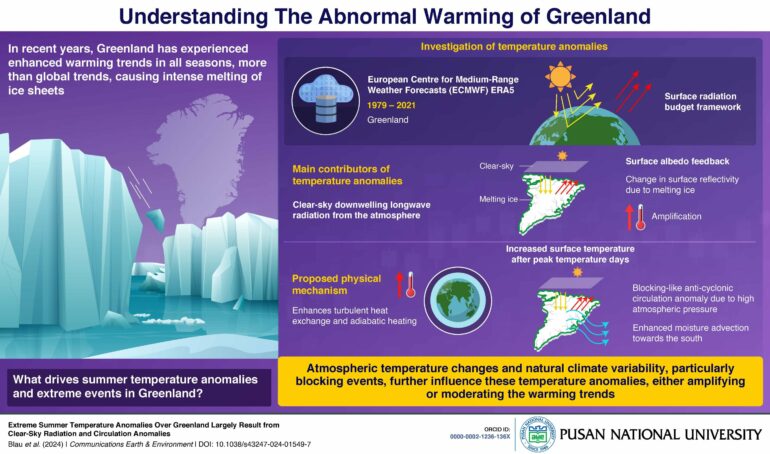Global warming, driven by human activities, has led to rising average temperatures worldwide. However, Greenland has been warming at an even faster rate than the rest of the world, leading to accelerated ice sheet melting. This intensified warming in the northern regions, known as Arctic Amplification, has the potential to raise sea levels significantly, posing a threat to coastal areas and ecosystems globally. Understanding the drivers behind this phenomenon is crucial for predicting future climate impacts.
Studies have previously attributed Arctic Amplification to local climate feedback processes, heat release from the Arctic Ocean, and energy transport from the south. Melting sea ice during summers further amplifies warming trends through a process known as surface albedo feedback, where less ice leads to less sunlight being reflected into space.
Additionally, the Greenland blocking index—a climate mode indicating the strength of high-pressure blocking conditions over Greenland—has been linked to temperature trends in the region. However, past studies have primarily focused on overall warming trends, often overlooking the specific causes of extreme year-to-year temperature events and relying mainly on energy balance models.
To address these gaps, a team of researchers from Korea, led by Professor Kyung-Ja Ha, from the Department of Climate System at Pusan National University, including Manuel Tobias Blau, also from Pusan National University, and Dr. Eui-Seok Chung from the Division of Atmospheric Sciences at Korea Polar Research Institute, investigated the anomalous warming trends in Greenland from 1979 to 2021.
“In this study, we focused on the year-to-year perturbations of the surface energy budget to explain Greenland’s extreme temperature,” explains Prof. Ha. Their study was published in the journal Communications Earth & Environment on July 28, 2024.
The researchers employed a surface energy budget framework, which separates the contributions of radiative and non-radiative sources, to analyze temperature anomaly events over Greenland. Their findings revealed that increases in clear-sky downwelling longwave radiation—the heat radiated by the atmosphere to the surface on clear-sky days—and the resulting surface albedo feedback were the dominant factors in Greenland’s surface warming.
The researchers also investigated the mechanism for this increase in clear-sky radiation and found an increase in atmospheric temperature as the primary driver. Specifically, in warm years, the combination of increased surface temperatures and tropospheric warming led to turbulent heat exchange between the atmosphere and the surface.
This process also enhanced moisture transport from the south to Greenland and contributed to the formation of a high-pressure system, resembling a blocking anticyclone, which trapped and sustained warm conditions. These dynamics resulted in intense ice melting, creating a feedback loop that further amplified the warming effects. Moreover, different modes of natural climate variability, particularly those related to the blocking index, can either amplify or moderate these warming trends, leading to extreme temperature events.
“The results suggest a significant impact of natural variability in explaining the atmospheric anomalies leading to extreme summers over Greenland,” says Prof. Ha. “Considering climate change, the extreme summer temperature over Greenland will further accelerate the ice sheet melting, leading to a rapid sea level rise.”
By shedding light on the drivers of Greenland’s extreme summer temperatures, this study offers crucial insights that could help project the future development of the Greenland ice sheet and inform strategies to prevent further degradation.
More information:
Manuel Tobias Blau et al, Extreme summer temperature anomalies over Greenland largely result from clear-sky radiation and circulation anomalies, Communications Earth & Environment (2024). DOI: 10.1038/s43247-024-01549-7
Provided by
Pusan National University
Citation:
Surface energy budget analysis reveals causes of Greenland’s abnormal warming (2024, August 27)



